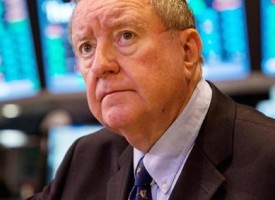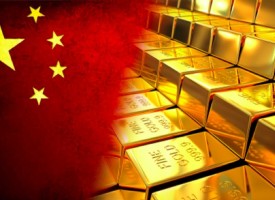Today one of the greats in the business who is connected in China at the highest levels says regarding gold, how many zeros are enough…maybe $15,000?
Gold: How Many Zeros Are Enough?
June 17 (King World News) – John Ing: With the pandemic disrupting lives and the global economy, government borrowings have climbed ever higher. US unemployment is nearly at Great Depression levels and a summer of civil unrest raises the stakes in an upcoming US election already lost in the wreckage of Covid- 19 with more than 120,000 fatalities to date.
We believe the Covid-19 pandemic is the seminal event of our generation, which will have a massive global and geopolitical influence. True, despite nearing half a million deaths globally, many more lives will be lost, particularly in the US where incoherent measures, easing lockdowns, and the lack of leadership have resulted in the failure to contain or even suppress the virus. True, the virus respects no border, political stripes nor economic strata, yet governments have declared victory prematurely and reopened their economies, more for political reasons. Mr. Trump may be finished with the virus, but the virus is not finished with us. And true, in the post- pandemic world we’re not returning to where we were, it is to be the “never normal” instead.
United States of Infection
Indeed, history shows that these seminal events set off chain reactions, aftershocks and trends that we only see afterward. We believe that the pandemic’s aftershock will have economic, political, social, and military affects, particularly with the US – China relationship at historic lows. The economic policy response has been massive and global, uniting the world against a common foe with central banks throwing everything but the kitchen sink, including draconian lockdowns. The bailouts keep piling up, billons, trillions, there are not enough zeros. A trillion or two here and tens of trillions there. Significantly, the shock has disrupted global supply chains and trade, at a time when economic activity is now at its weakest since the Great Depression, exposing the interdependence of countries who are insourcing everything from ppe to cars to phones to semiconductor chips.
While the 2008-2009 financial crisis was mainly a financing problem in Wall Street, this time it is an economic problem with global casualties. The UN has calculated the pandemic has wiped out $8.5 trillion of global output, replaced by some $10 trillion of government bailouts. To be sure, the economic fallout from the coronavirus has raised the risk of sovereign defaults, particularly in those developing countries which lack the savings and institutions, which are now in terrible financial shape. Then there is the eurozone with its chronic debt problem between the northern and southern members made worse by Germany’s top court’s intransigence as it ruled that the ECB exceeded its mandate when it unleashed its bailout scheme, setting up a constitutional crisis in the European Union.
A worse thought though is the collapse in trust in America, recklessly deconstructing its own framework. In becoming the world’s largest debtor, after decades of cheap money, the United States has seen a collapse of trust in its economic and social make-up, exposing the country to fragmentation while its finances will be severely hit as the pandemic accelerates. The failings of capitalism, polarisation and racial inequality have robbed America’s moral standing. Ironically a new era of protest and a broad radicalised electorate appears to be fueling the force that could actually change the system. Nonetheless, despite the stock market’s rebound, retracing more than half of the coronavirus sell-off, harder times are ahead once the economic hardship from the pandemic materializes in the coming months or years.
Debt Trap
The pandemic has laid bare many unpleasant truths about the United States that we know exist but markets prefer to ignore. Too long America took for granted the longest economic expansion on record, financed by a large debt, denominated in a currency they can always print, ensuring they would never become insolvent. But now, the United States has weaponized this currency and despite its financial edge, its big spending today limits their options. The world faces a global recession, maybe worse than the Great Depression and although the world is much more interconnected, deglobalisation and the pandemic have weakened confidence in the United States and the dollar, just at a time when US exceptionalism has run its course.
In fighting the pandemic, the White House has put opening up the economy a priority, ahead of science and certainly guaranteeing a virulent second wave of Covid-19. But it is not only in the fight against the virus, but in the effort to resurrect the economy in time for the November elections, the White House has racked up record amounts of debt skewing the stimulus to households over businesses. It is politics at all costs, including the abrogation of long standing geopolitical relationships in favour of an “America First” policy. Trade wars and demonizing China, no doubt resonates in key electoral states, but drives a wedge between nations, ending decades of cooperation. This polarizing action is not dissimilar to the protectionist environment that worsened the Great Depression. Of concern is that the “beggar thy neighbour” mercantilism did not work then and won’t today.
Today, America’s isolation measures won’t help them when they need help with their finances. Sadly, it is politics that trumps all, which makes it the 1930s all over again. It is not so different this time.
For the past few decades, the United States built a consumption economy based on the service sector. Today consumer spending accounts for 70 percent of US economic growth. After the 2008-2009 financial crisis, the financial sector was given a boost as rounds of quantitative easing (QE), and near zero interest rates helped inflate asset prices and resurrect the economy, however the cuts also cut the returns on debt, which penalized savers as yields evaporated widening the wealth gap. And, as investors chased returns, property and the stock markets were the main beneficiaries of this easy money as Wall Street became easy street, bypassing Main Street.

America became the envy of many as everyone chased the American dream. But the dream was both elusive, non-inclusive and debt dominated. And soon, America began running larger fiscal and current account deficits financed by ever larger pools of foreign capital, much of it from Asia who had a surplus of savings, and of course dollars. There is no way to know how much debt is too much. The key is that the US can get away with a lot economically as long as it remained politically credible. Noteworthy, is that it took 6 years after the 2008 crash, for unemployment and the economy to get back to 2008 levels, in contrast to the Great Depression, which took 23 years. To be sure it won’t take a few months as the ostrich-like investors are hoping for. It might take years, maybe decades, a lost decade or even a lost generation. November will be very important.
Two Nations
Amid the divisiveness of the material, racial and political climate, Mr. Trump has resurrected his old scapegoat, demonizing China. After a drawn out trade war that left both countries weaker, the White House has escalated tensions between the US and China, beyond trading verbal blows over the pandemic, making technology markets a key source of friction. In an attempt to curb US ownership, Mr. Trump ordered the government’s pension fund to no longer invest in index funds, which included Chinese companies. And in a further move that raised the stakes in this new Cold War, the White House threatened to revoke Hong Kong’s special status.
And in this financial war, currency is to be the next pawn and as China’s renminbi has fallen against the greenback, unwittingly producing another advantage for China, particularly at a time when both sides earlier pledged to avoid competitive devaluations. Yet, in weaponizing the dollar, Trump makes it easier for the world’s second largest economy to export its way out of the Covid-19 slump, something the Americans can’t and need. China too has turned inward, becoming a massive consumer to its demographic weight of 1.4 billion people, rather than just a producer with export-led growth. Will American multinational giants in a tit-for-tat move be blocked from the world’s largest market?
With little trust between the two, President Trump’s actions of decoupling from China and ending decades of mutual dependence, risks backfiring as the ratcheting up of hostilities emboldens China’s leadership. For example, rather than an earlier cooperative relationship, China instead called Trump’s bluff, throwing down the gauntlet with the national security law on Hong Kong. The trade deficit with China has grown even wider as US exports collapsed, but Chinese imports rebounded reflecting the desynchronisation with the world still mired in a health crisis. And not surprisingly the Phase 1 trade deal is stillborn and part of a long list of contention. Of deepening concern is that Beijing is also threatening to “weaponize” its position as the world’s largest creditor and the global hegemon has chipped away at America’s financial hegemon status. America’s game of chicken could hurt both sides.
A further example is China flexing its financial muscles, paring its huge $1.3 trillion dollar holding of US debt of a total $3.1 trillion of foreign exchange reserves and abstaining from recent treasury auctions. Both China and Russia have converted some of their vast dollar holdings into gold in a diversification move. China is also creating a digital version of the renminbi which could internationalize the currency and Chinese banks’ total assets now rival those of American and European banks, financing champions Alibaba, Meituan and Tencent (ATM). This group is among the world’s giants, having set up digital wallets rivaling, bypassing and competing with America’s big banks. China’s vast investment and trade network is its backbone and helps internationalize the renminbi, aiding the “Belt and Road” initiative modeled after America’s “Marshall Plan”. China also suspended debt repayments for 77 developing countries using its soft financial power, enhancing its reputation and boosting its global standing.
China plans a “Big Bang” to give impetus to its financial markets, opening its markets and access to the mammoth $131 trillion bond market that is twice the world’s GDP. The US Senate passed a bill that may blackball Chinese listings but already direct Chinese investment has fallen from $45 billion in 2016 to a paltry $3 billion, at a time when both countries need investment. Chinese companies listed on foreign exchanges have a global market cap of almost $2 trillion and almost all will list on Hong Kong, one of the world’s leading exchanges. Both countries are losers. At the same time, the Hong Kong Stock Exchange will offer futures and options on 37 of MSCI’s equity indices, cementing Hong Kong as a major financial centre despite the current brouhaha. Hong Kong is one of the world’s largest equity market and home to 420 hedge funds.
The Thucydides Trap
Of importance is that Covid-19 portends change. The status quo before the pandemic won’t return as the “never normal” reshapes our institutions, political systems, and globalism itself. For the latter part of this century, America has been ascending and dominant as the world’s leading nation. But today the pandemic will most likely change the world order and ensure that the balance of the century is likely to be an Asian one, as the late 20th century was an American one. Ironically, it is America’s destruction of its own institutions, abrogation of agreements as part of the “America First” polarization and response to the virus that jeopardizes its primacy. It will be remembered as a turning point. History will show that it was not that the Chinese sent face masks or airlifted ventilators, or the virus, but that they had the savings and financial wherewithal to step into the vacuum left from an isolated America.
Amid the escalation of tensions between Beijing and Washington, nations are left to choose between the US and China. For example, Mike Pompeo, US Secretary of State recently chastised ally Australia for choosing to join China’s Belt and Road programme aimed at building infrastructure across Asia, and so threatened to push Australia out of the US “Five Eyes” intelligence sharing partnership. Canada too, the United States’ closest ally was also threatened of being ousted. Left unsaid, what would happen if America’s traditional allies opted to support the Chinese and not the US? Or in the race for a vaccine, what would happen if the Chinese discovers one or two vaccines?
For some time we have noted that the new cold war between the two superpowers has uncanny similarities to earlier periods when rivalries between established and rising powers eventually led to war. In fact, Professor G.T. Allison of Harvard observed that in the Thucydides Trap, over the past 500 years of history, when a rising power threatened to replace the established power, that in 12 of the 16 cases, the end result was war. Only in four of those cases, there was no war. We believe that the Covid-19 pandemic has changed the world and that in the “never normal” world, countries are facing inward for self-sufficiency and that the virus not only changes trends, but accelerates them. Of concern, is what little there is between them, can these two superpowers escape the Thucydides Trap?
Chicken in Every Pot
Herein lies the problem. To avoid a depression, central banks have stepped into the breach and backstopped their respective economies in a “chicken in every pot” promise, ironically used in Hoover’s 1928 presidential campaign. Central banks have and proposed to buy government bonds and corporate shares on an unprecedented scale, using their balance sheets as they did in the financial crisis in 2008-2009, but this time the global economy is on life support.
The Fed again has led the way, with the fiscal bazookas of four and now five rounds of quantitative easing (QE – to infinity). The Fed also pledged to purchase investment grade corporate bonds as part of their support of the debt markets, again using its balance sheet but now the portfolio holds bankrupt Hertz bonds. Britain, Japan and eurozone countries soon followed, pledging to buy $6 trillion plus worth of assets between them. The Fed has even backstopped the commercial paper market, further distorting the market by pushing borrowers into longer dated paper, creating a vacuum and funding problem.
While the big spending measures are viewed as temporary, governments are running history’s biggest budgetary deficits as they hand out checks to their citizens and businesses. Fiscal and monetary policy has become one. Yet in becoming an instrument of the government, turning debt and borrowings into money, the Fed’s mammoth money creation is not dissimilar to what has happened in many Latin American countries, Zimbabwe or Weimar Germany.
On the face of it, there is almost $3 trillion in stimulus to support the US economy on top of the $4.7 trillion of budgetary spending announced before the pandemic hit. Because some of the stimulus programmes has been spent, the Democratic-led House passed an additional round of up to $3.5 trillion of stimulus spending for a total spend of almost $10 trillion or 50 percent of GDP, rivaling the government expenditures at the height of World War II. Soon this massive supply of debt will dwarf asset purchases. Debt has become so cheap that issuances have swamped central bank intentions with debt levels over 130 percent of GDP according to the IMF, far above the crisis levels of 2008. Already the taxpayer through their central banks will be on the hook in purchasing up to a third of the debt to fill the vacuum left without the traditional check writers like China. Someone is to discover that money does not grow on trees.
Ponzi Scheme
And, few care because we are told the US dollar is deep in liquidity and after all, is the world’s dominant reserve currency mandated in the Bretton Woods Agreement in 1944 that pegged the dollar to gold. When the dollar became the bedrock of the world’s financial system, the rest of the world followed, fixing their currencies to the dollar. However all good things must past, and after two decades of excess money printing to pay for the Vietnam War and the “Just Society”, the system fell apart and the United States was forced to sever the gold linkage in 1971, devaluing the dollar to give the economy a boost. Of course, inflation soon followed with Paul Volcker stopping the slide into hyperinflation. Since then, the Fed has become the ring master and without the discipline of gold, the Fed printed more cheap dollars funding Japan, Germany and China who recycled their excess dollars in a quid pro quo move into America’s debt securities.

Simply put, America’s prosperity and profligacy was financed by the world in a Ponzi scheme, of borrowing dollars to close their financing gap, financing the purchases with newly minted dollars.
The plan was almost too perfect. When foreigners finally balked at financing America’s spendthrift ways, the Fed simply replaced those foreign dollars with dollars printed from its balance sheet. However, the Trump presidency has taken America to a place it has never been. Since 2007 (before the last crisis) the Fed’s balance sheet has exploded from $800 billion to almost $7 trillion, and over the next 18 months is expected to top a whopping $12 trillion or almost 50 percent of America’s GDP, double the 2008 financial crisis. America’s debt at $26 trillion is the largest in the world.
Hostage to the Printing Press
Those days are over. Therein lies the weakness or Achilles heel of America’s financial hegemony. Until the last decade, America was content to use the dollar and its financial markets as the world’s ecosystem to promote trade, prosperity, influence and to finance shortfalls. America and the world prospered. But in the aftermath of 9/11, America chose to weaponize its influence, sometimes imposing sanctions, sometimes blocking others from dollars and sometimes threatening to change the world order. And despite a shrinking share of the world’s gross domestic product, the dollar’s supremacy depended more upon America’s economic and military might, as well as the strength of its institutions and agreements. But it is the abuse of this strength that the Trump administration has undermined the dollar’s status as the dominant global reserve currency. The mismatch changed when America took advantage of its financial powers, to impose sanctions on Russia, Iran, Iraq, and Venezuela or started trade wars with allies and restricted countries from the American dominated SWIFT payment system.
America is isolated. America is mired in a health crisis, economic and political crisis. Lacking in savings, the United States is heavily dependent upon foreign flows of capital to finance its massive deficits particularly given the government’s huge financing needs. A reduction in foreign flows has forced the Fed to fill the shortfalls with newly printed dollars, resulting in a recent steady deterioration in the dollar which is at its lowest since January.
And while America flexed its financial muscles, others such as China, Russia and the Middle East players have started to build alternate payment systems, even replacing SWIFT, the global payment system supported by America. Then with the collapse in oil and the fraying of ties with ally Saudi Arabia, oil once priced in dollars is now priced in renminbi, roubles and yen. It seems in the post pandemic era, the world is entering a post-dollar era as the markets balk at financing a nation that spends twice as much as they bring in, and tells the world they don’t need them. It is not so different this time. To hedge against the deterioration of the world’s reserve currency, investors instead have migrated to other hard assets, like gold.
Inflation is Back
Central banks have relegated inflation as a relic of the past. Simply put, inflation is the consequence of too much money chasing too few goods. All this leads to our belief that once the lockdowns ease and, thanks to the unprecedented boost in fiscal and monetary measures and the decimation of the supply side, the pandemic will lead to double-digit inflation. Trump’s trade wars also brought forward deglobalisation, which has already increased costs, yet another inflationary input. And in the “never normal” climate to come, there will also be upward pressure to increase the value of former poorly paid “front line” labour, leading of course to more inflation. Ironically, lawmakers after providing unemployment benefits of $2.2 trillion to 40 million plus out of work Americans, almost two-thirds of the recipients made more money than they were making before the crisis. As a result, lawmakers are considering a bonus to lure those workers back. To be sure, the costs of stemming the widespread unemployment are high but the major problem is how to wean the US economy and its workers off the support measures who have become addicted to the largesse. Reopening will also have high costs with yet another spending blowout likely, even before the upcoming electoral chaos of November.
Because of America’s exploding deficits and the lack of foreign funding, the Fed keeps finding new and improved ways to print dollars. Quantitative easing allowed the bank to purchase vast quantities of government and corporate debt with money borrowed or printed. Then taking a page from the Democrats, adopted Modern Monetary Theory (MMT) which conveniently allowed the Fed to print money with impunity providing unlimited funding, under the guise that the consequential economic recovery will pay for the stimulus package – a sort of reworked supply side argument. Like other radical experiments, quantitative easing, supply side and now MMT, no one speaks of the cost, only the rationale. The cost? Higher inflation, more debt and a debased currency. The dollar days are doomed.
And most likely, since inflation is one of the few and easy ways for governments to cut the public debt burden, we expect a new age of “austerity”, increased taxation on taxpayers, yet another inflationary input. Finally in the never normal climate, the American people will elect an inflationary president and Congress in November, as there is no appetite for austerity and more hardship. That will be good for gold, but bad for the dollar.
Gold Is an Alternative to Money
The current administration views the Covid-19 pandemic through rose coloured glasses, as it eases the lockdown, while the virus deaths continue to spike. Similarly then, investors’ rose coloured lenses see an economic recovery whilst half the population is unemployed. And, despite record amounts of debt, the government believes they can always spend more. These rose coloured views are wrong. Politics are at play and thus the rosy outlook.
Most important, it is wrong to dismiss the pile of debt and that the savings, which lent to governments, companies and now handed to households will remain intact. The surge in debt that drove rates down, fuelled a stock market boom and widened the wealth gap, has left taxpayers and households paying interest on a debt that keeps piling up, while the government prints its obligations away. This cannot last. A collapse in the dollar, stock market and bond market is the new reality. It doesn’t take rose coloured glasses to show that gold is a barometer of investor anxiety – it will be a good thing to have. Gold’s rally is built on fear.
We believe that the steady erosion in the value of the dollar and gold’s uptick is a sign that the market is worried that the Fed has lost control in its ability to manage the nation’s needs. Gold is priced in dollars and recently hit an eight year high. The rise in gold can be seen as a devaluation of the dollar. Gold has also posted record highs in other currencies. Since year end, gold has risen almost 13 percent in terms of dollars outpacing stock markets. That revaluation has further to go. Central banks led by Russia and China have been a big buyer of gold. Global broad money supply (M3) or stock of money has soared to an estimated $90.4 trillion and that is before the recent massive stimulus programmes.
The US has a serious problem with its deficits and overvalued dollar. If they continue to print money, whether by economic stimulus or to stave off corporate bailouts, the fear of currency debasement and consequential inflation will undermine the dollar. The Fed remains the largest holder of gold. If gold is a finite currency, its value not just against the dollar, but euros and yen too should rise in value. The total gold supply is some 170,000 metric tonnes. Scaling the money supply today and deflating by the gold supply, the price of gold would be in excess of $15,000 an ounce. We are not so optimistic but continue to view $2,200 an ounce as a reasonable near term target.
And there are technical reasons for gold posting new highs. The gap between the physical and future markets is closing as the bullion banks, such as HSBC and Scotia Mocatta have exited the market, after taking millions of losses. The bullion banks were often on the “short” side of the market and instrumental in capping the physical market with an onslaught of futures contracts on the Comex, the futures exchange. Their net short positions to hedge positions in London blew up when Swiss refineries closed down because of Covid-19 and at the same time there was a surge in physical gold demand, which caused a spike in the gold price. Bullion bank players, HSBC took a $200 million loss and Scotia Mocatta started in 1684 closed down with a $160 million writedown by Bank of Nova Scotia. At last, the physical market without the future overhang saw a pickup in demand as the Shanghai Gold Exchange, now the largest physical player in the world saw record demand. Covid-19 has unwittingly disrupted the supply chain of the market and today there is a solid underpinning to the market. This bull market has just begun.
Did You Miss Kirkland Lake Gold’s 50-Fold Share Price Increase?
Kirkland Lake Gold Skyrocketed From $1 To Over $50!

Two Billionaires Just Bought Huge Stakes In The Next Kirkland Lake Gold!
To find out which company two billionaires just bought huge stakes in what they believe will be the next Kirkland Lake Gold click here.
Take A Look At This…
***Also Released: ’08-’09 All Over Again, Yet Another Warning Sign, Big Troubles, Plus Look At What Is Hitting All-Time Highs CLICK HERE.
***To listen to the powerful new trend that Gerald Celente predicts will engulf the world click here or on the image below.
 © 2020 by King World News®. All Rights Reserved. This material may not be published, broadcast, rewritten, or redistributed. However, linking directly to the articles is permitted and encouraged.
© 2020 by King World News®. All Rights Reserved. This material may not be published, broadcast, rewritten, or redistributed. However, linking directly to the articles is permitted and encouraged.







